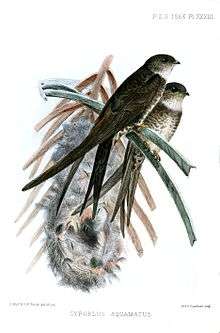Neotropical palm swift
| Neotropical palm swift | |
|---|---|
 | |
| | |
| Fork-tailed Palm-Swift flying over Apiacás, Mato Grosso state, Brazil | |
| Scientific classification | |
| Kingdom: | Animalia |
| Phylum: | Chordata |
| Class: | Aves |
| Order: | Apodiformes |
| Family: | Apodidae |
| Genus: | Tachornis |
| Species: | T. squamata |
| Binomial name | |
| Tachornis squamata (Cassin, 1853) | |
The Neotropical palm swift or fork-tailed palm swift (Tachornis squamata) is a resident breeding bird from Colombia, Venezuela, the Guianas and Trinidad south to northeastern Peru and Brazil.
This small swift is found locally in marshy habitats, or sometimes open forest, usually near Moriche Palms. It builds a C-shaped nest of feathers, saliva and plant material on the inside of the dead leaf of a Moriche Palm. Three white eggs are laid in the depression of the C, and incubated for 21 days to hatching.
Neotropical palm swift is a slender, narrow-winged species, 13.2 cm long, with a long forked tail, and weighs 11 g. The call is a buzzed djjjjjj, like an insect. The nominate western form T. s. squamata has black-brown upperparts with a slight greenish gloss. The underparts are a paler brown with a white throat and central underbody. The eastern race T. s. semota of Trinidad, the Guianas and central and eastern Brazil is much darker, almost steel-black above and darker brown below. Juveniles are very similar, but have buff fringes to the upperparts and head in fresh plumage.
Despite its shape and association with palms, it is in a different genus to the Asian and African palm swifts.
Neotropical palm swift feeds in low flight on flying insects. It normally stays at less than 10 m above the ground. It normally occurs in small groups of up to 30 birds.
References
- ↑ BirdLife International (2012). "Tachornis squamata". IUCN Red List of Threatened Species. Version 2013.2. International Union for Conservation of Nature. Retrieved 26 November 2013.
- Swifts by Chantler and Driessens, ISBN 1-873403-83-6
- Hilty, Steven L (2003). Birds of Venezuela. London: Christopher Helm. ISBN 0-7136-6418-5.
- ffrench, Richard (1991). A Guide to the Birds of Trinidad and Tobago (2nd ed.). Comstock Publishing. ISBN 0-8014-9792-2.
External links
- Fork-tailed palm swift photo gallery VIREO
- Photo-High Res; Article flickr.com
